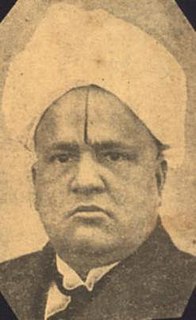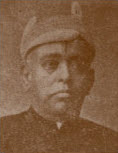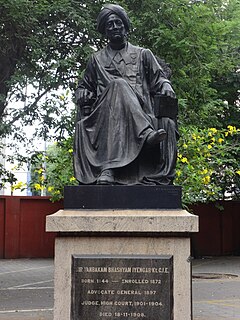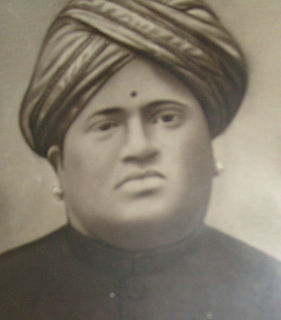
Raja Sir Tanjore Madhava Rao, KCSI, also known as Sir Madhava Rao Thanjavurkar or simply as Madhavarao Tanjavarkar, was an Indian civil servant, administrator and politician who served as the Diwan of Travancore from 1857 to 1872, Indore from 1873 to 1875 and Baroda from 1875 to 1882. He was the nephew of the former Diwan of Travancore T. Venkata Rao and the son of another Ranga Rao.

Seshadri Srinivasa Iyengar CIE, also seen as Sreenivasa Iyengar and Srinivasa Ayyangar, was an Indian lawyer, freedom-fighter and politician from the Indian National Congress. Iyengar was the Advocate-General of Madras Presidency from 1916 to 1920. He also served as a member of the bar council from 1912 to 1920, the law member of Madras Presidency from 1916 to 1920 and as the president of the Swarajya Party faction of the Indian National Congress from 1923 to 1930. Srinivasa Iyengar was the son-in-law of renowned lawyer and first Indian Advocate-general of Madras, Sir Vembaukum Bhashyam Aiyangar. Iyengar's followers called him Lion of the South.

Rao Bahadur Sir Vangal Thiruvenkatachari KrishnamachariKCSI, KCIE was an Indian civil servant and administrator. He served as the Diwan of Baroda from 1927 to 1944, Prime Minister of Jaipur State from 1946 to 1949 and as a member of the Rajya Sabha from 1961 to 1964.

Diwan Bahadur Sir Perungavur Rajagopalachari, KCSI, CIE, also spelt in contemporary records as Sir P. Rajagopala Achariyar, was an Indian administrator. He was the Diwan of Cochin State from December 1896 to August 1901 and of Travancore from 1906 to 1914.

Diwan Bahadur Sir Vembakkam Bhashyam Aiyangar was an eminent lawyer and jurist who served as the first Indian Advocate-General of Madras Province and also as a Judge of the Madras High Court.
Diwan Bahadur Rishiyur Venkata Srinivasa AiyarCIE was an Indian civil servant, legislator and politician from the Madras Presidency.
Diwan Bahadur Cozhisseri Karunakara Menon (1863–1922) was an Indian journalist and politician from the erstwhile Madras Presidency. He was the second editor of The Hindu after G. Subramania Iyer and the founder of the Indian Patriot.

Rao Bahadur S. A. Saminatha Iyer, also known as Thanjavur Saminatha Iyer, was an Indian lawyer, landlord, politician and theosophist who served as Chairman of the Tanjore municipality and a delegate to the 1885, 1886, 1887, 1889 and 1894 sessions of the Indian National Congress. He spoke against salt tax in the first session conducted in 1885 and in 1887, was a part of a 32-member team that wrote the constitution of the Congress. Christopher Baker and D. A. Washbrook describe him as the "most celebrated spokesman of the Tanjore gentry".
S. Kasturi Ranga Iyengar was an Indian lawyer, Indian independence activist, politician and journalist who served as the managing director of The Hindu from 1 April 1905 till his death in December 1923.

Chettipunyam Veeravalli RungacharluCIE, also spelt as Rangacharlu, was an Indian civil servant and administrator who served as the Diwan of Mysore kingdom from 1881 to 1883. He was the first Diwan of Mysore following the restoration of monarchy in which Maharaja Chamaraja X promised to follow modern system of administration.
Diwan Bahadur Rayapuram Nallaveeran Arogyaswamy Mudaliar was an Indian politician and civil engineer who served as the Minister of Excise, Medical Administration and six other departments in the Madras Presidency from 1926 to 1928.
Diwan Bahadur T. RangachariCIE (1865–1945) was an Indian lawyer, politician, journalist, legislator and Indian independence activist.
Diwan Bahadur Thodla RaghavaiahCSI was an Indian administrator who served as the Diwan of Travancore from 1920 to 1925. He was a favourite of the Maharaja Moolam Thirunal. His refusal to allow low-caste to enter Hindu temples is believed to have led to the Vaikom Satyagraha.

Diwan Bahadur Raghunatha Rao Ramachandra Rao was an Indian civil servant, mathematician and social and political activist who served as District Collector in British India.
Srinivasa Raghavaiyangar Rangaswami Iyengar was an Indian lawyer and journalist who served as the editor of The Hindu from 1923 till his own death in 1926. He was the son of S. Srinivasa Raghavaiyangar and nephew of S. Kasturi Ranga Iyengar.

General elections were held in British India between 28 October and late November 1926 to elect members of the Imperial Legislative Council and the Provincial Legislative Councils.
Diwan Bahadur Sir Thyagaraja Sadasiva Iyer M.A., B.L., was an Indian judge and theosophist who served as the Chief Justice of Travancore from 1905 to 1910. He was also the first President of the Hindu Religious and Charitable Endowments (HR&CE) Board, Madras Presidency.
Soundararaja Iyengar Parthasarathy was an Indian journalist who served as editor-in-chief of The Hindu from 1959 to 1965.
C. R. Srinivasan was an Indian journalist who served as Managing Director of the Tamil language newspaper Swadesamitran from 1934 to 1962.
Ambujammal Desikachari née Srinivasa Iyengar was an Indian independence activist and women's rights activist. A Gandhian, she participated in the Civil Disobedience Movement and served as Vice-President of the Tamil Nadu Congress Committee. Ambujammal was awarded the Padma Shri in 1964. She died in 1993.












